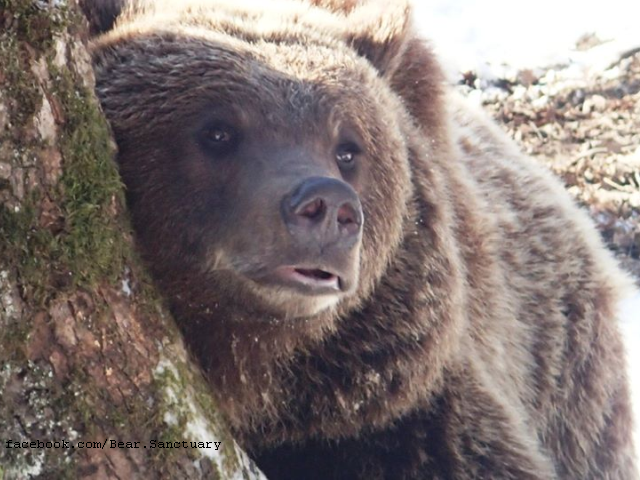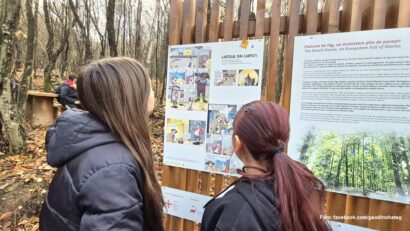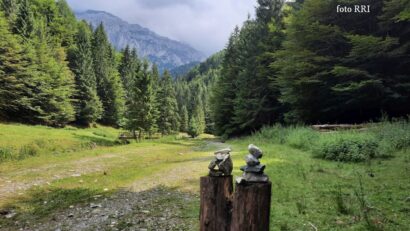The bear sanctuary in Zarnesti
Protecting the brown bears in Romania

România Internațional, 31.07.2020, 14:00
Zarnesti is a
town in Brasov County. On the outskirts of the town you can find the world’s
largest bear sanctuary. It was officially inaugurated in 2008, by the Millions
of Friends Association and the World Association for the Protection of Animals.
More than 100 bears found their peace here; they had been saved from a cruel
and abusive life in captivity. Each of the bears has their own story. Some of
them were saved from being kept in suffocating cages, being a mere reason for
people to have fun in restaurants, hotels, factories, gas stations, circuses or
even monasteries. Others were brought over from zoos around the country that
couldn’t afford offering bears normal living conditions, or from illegal bear
owners. Here in Zarnesti the bear sanctuary has a surface area of 70 hectares
of forest and grazing grounds. Water tanks, trees for climbing, feeding areas
and individual shelters have been made available on the premises. In fact, the
bear sanctuary was born from the grief and pain caused by the death of a
she-bear, Maya, which had been kept in captivity for the amusement of tourists.
Maya was saved by the president of the Millions of Friends Association,
Cristina Lapis, who is also the founder of the sanctuary.
Cristina Lapis:
It has been 15 years since the sanctuary was founded and it would not have come
into being had the she-bear Maya not died in my arms, having maimed herself
eating her front paws. That she-bear was illegally kept in a cage nearby Bran
Castle at a guesthouse, allegedly used as an attraction point for the potential
clients. All foreign tourists who travelled to Romanian and who passed by that
guesthouse could see for themselves the bear’s gruesome facilities and
announced the World Animal Protection Association. I was contacted by that foundation;
they asked me to go check if the living conditions of the bears were that
serious. There were also other bears from Poiana Brasov, nearby the Poiana
Ursului hotel, who were tortured, which prompted me to vow that someday, those
bears would be free again. I began by asking what the prospective solutions
were, for the bears, I had the support of the authorities telling me to rest
assured that, if I created a sanctuary for those bears who had been kept in
improper conditions for a wild animal, I would get all the support I needed.
And that’s how the adventure started. Back then it didn’t even cross my mind we
would have as many as 106 bears, which is the number of bears we have at the
moment. And that is how Romania can now boast the biggest brown bears
sanctuary. That is how, in 2016, Romania had the world’s most ethical
sanctuary, second-placed being a gorillas sanctuary, while the third largest
such area was an elephants sanctuary.
The bears in
Zarnesti can never be released in the wilderness since they can no longer adapt
to wildlife. Many of them cannot stand seeing or hearing human beings, as they
had been much too traumatized by humans.
Cristina Lapis:
In recent years, we took the bears
that were confiscated by the National Environment Guard, they were bears kept
at the bread Factory, at the uranium Factory, at monasteries, they were bears
kept near the petrol pump. These places are absolutely incredible for an animal
to be kept in. They were kept there because the Romanian made a habit of that, in
the past the Romanians used to be bear leaders but also circus performers, they
were bear tamers, taking them to the market towns, while towards the end of her
or his life, the bear was a trophy but also a money-making device. A bear that
was shot in his cage in Poiana Brasov was a bear with a net worth standing at
around 10,000 – 15,000 Euro. The bear is the king of the Carpathian forests and
it is a pity to put them in a cage and mock them. It is one of Romania’s great
treasures, and it must be protected. Not only because it is a richness of our
forests, but also because there is the International Convention in Berne
Romania signed and ratified through a law, officially acknowledging the fact
that the brown bear was a protected animal. Unfortunately, we were unable to
gather all the bears. In Romania, there are around 10 or 15 bears that are kept
in the same conditions. For instance, at a guesthouse in Straja, this year there
will be 20 years since a bear has been kept in a cave. 20 years! One year after
the next the bear gets a birthday cake and is given beer to drink. The footage
has been posted on YouTube and the whole world can see we keep a bear near a
guesthouse to draw clients to that guesthouse. For 10 years we have been trying
to persuade the authorities to release it and take it to a sanctuary, to a zoo,
to a proper place…
Romanian boasts Europe’s largest population of bears;
they prefer vast and thick forests, less frequented by the man. Unfortunately,
the increased pressure the forests have been under has lead to a great many
incidents. Some bears climb down to households, doing a lot of damage.
Cristina Lapis:
As we speak, in our forests, or at
least what has been left of them, there is no forest fruit, there are no
mushrooms left, no nothing, as everything is taken away. So bears, no longer
having a source of food, come and look for it wherever they can smell it. And
if guesthouses, houses and villas are being built in forests, where everybody
can have a barbecue, we almost invite them over, so little wonder then that
they come. Of course the hungry bears are on the lookout for food. They do not
come to town because they want to take a walk around, it’s us that have been
trespassing and invading them! We took their lands away from them, we do not
provide the food they need, and the solution is a complex one. Shooting them is
not a solution either. Hotels, guesthouses, houses that are built along the
forest tree line should have protection, they should have an electric fence,
and the bear will stop there. In the towns and villages lying at the forest tree
line, people should grow apple trees and pear trees, as well as corn, and the
bear, searching for food, will stop there. Hunters’ associations and the
forestry authorities should provide bears with food during spring, just as they
used to do in the past.
The bears Sanctuary in Zarnesti will soon reach the maximum
of its housing capacity, so the Environment Ministry announced it would approve
the building of a new sanctuary for bears. Also, beginning this year, it has
been officially decided that the Romanians living in areas populated by bears
should receive subsidies for the purchase of electric fences, capable of
protecting their households. The authorities have also pledged they would
finance a research study on the population of bears, carried with the
state-of-the-art technology, so that we may exactly know the number of brown
bear specimens living on Romanian territory.






























